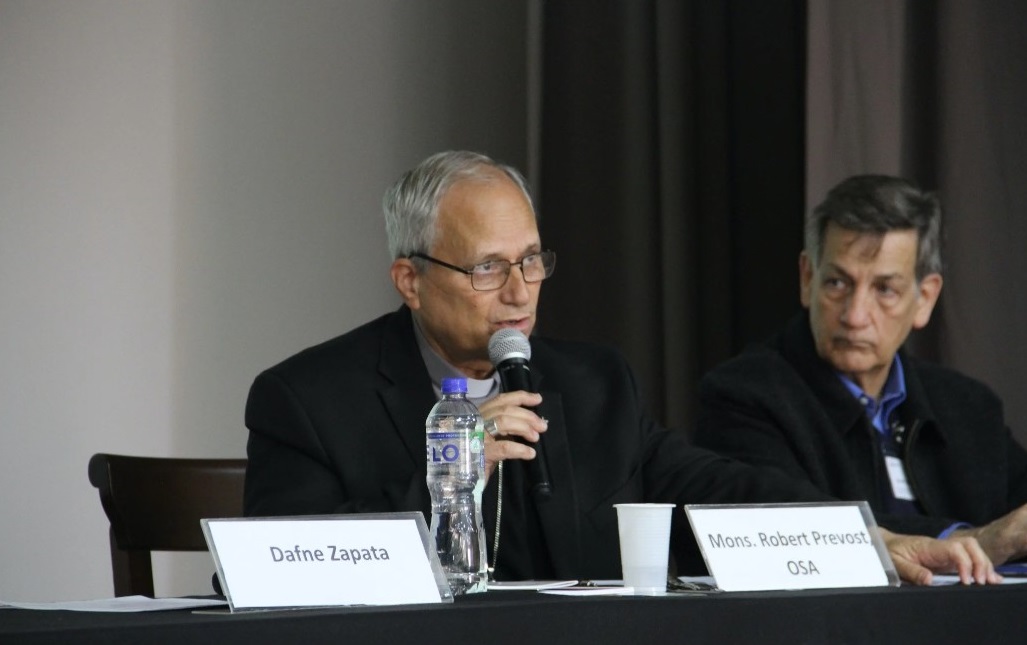VATICAN CITY (VATICAN CITY)
Los Ángeles Press [Ciudad de México, Mexico]
June 30, 2025
By Rodolfo Soriano-Núñez
After just over ten years, the idea of a zero-tolerance approach towards clergy sexual abuse is common currency in Catholic parlance.
[Photo above: Robert Prevost, while bishop of Chiclayo, attending a seminar on the clergy sexual abuse crisis in Peru, 2022. Peruvian Jesuits’ social media.]
A closer look into how zero-tolerance has been used by the Catholic Church dispels any notion of an effective understanding of what it entails.
As several cases, all over the world, prove zero-tolerance remains a catchphrase, a slogan of sorts.
A staple of Catholic Church discourse has been an idea of zero-tolerance towards clergy sexual abuse. As recently as last week, on Friday June 20, Peruvian media were happy to report news of Pope Leo XIV sending a personal letter to Paola Ugaz, one of the brave journalists who dared to risk prison to sound the alarm over the extent of the abuse at the Sodalitium of Christian Life.
At the same time, new information of cases in the Spanish-speaking world, proves how far the Catholic Church is from having learned the lessons from the crisis, and the need for an actual enforceable zero-tolerance policy.
Leo XIV’s letter stresses the suppression of that organization while praising Ugaz and other journalists. Although it does not explicitly address zero-tolerance, there is one paragraph where he talks about the need to “not tolerate any form of abuse”:
- Prevention and care are not a pastoral strategy: they are the heart of the Gospel. It is urgent to root throughout the Church a culture of prevention that does not tolerate any form of abuse, whether of power or authority, of conscience, spiritual, or sexual. This culture will only be authentic if it is born of active vigilance, transparent processes, and sincere listening to those who have been hurt.
Jordi Bertomeu, an official of the Dicastery for the Doctrine of the Faith in charge of the probe and suppression of the Sodalitium, read the letter on June 19, at the premiere of a play telling Ugaz’s and other journalists’ saga.
The Sodalitium was akin to a Catholic religious order, but closer to a holding of firms with deeply entrenched sect-like behavior. So harmful for the Catholic Church itself that, in his last days of life, Pope Francis suppressed them.
Vatican News in both English and Spanish published short pieces about the letter. An unofficial translation to English, after the Spanish-language original, is available here.
The letter proves how Leo XIV acknowledges the need to “not tolerate” abuse, while aiming at developing a culture “born out of active vigilance, transparent processes, and sincere listening to those who have been hurt.” In doing so, he offers the seeds for the development of a comprehensive zero-tolerance policy.
The pervasive gap
Sadly, despite Pope Leo’s letter, and Pope Francis’s efforts, the most notable the suppression of the Sodalitium, when confronted with the severity of the crisis, the Catholic Church has used zero-tolerance more as a catchphrase, a slogan, as the previous installment of this series, detailed in the case of the Legion of Christ, linked after this paragraph, than as an actual policy, with “teeth,” clearly stated goals, and some sense of accountability.
Leo XIV is not alone in his call to achieve vigilance, transparency, and willingness to acknowledge and repair mistakes. Prior to the Conclave electing Cardinal Robert Prevost, the Survivors Network of those Abused by Priests, SNAP, called for an actual zero-tolerance policy.
SNAP did so by endorsing a proposal carefully crafted by Nate’s Mission, a Milwaukee-based U.S. NGO, available as a PDF on their website here.
So, the time is ripe for the Catholic Church to follow through with a clearly stated zero-tolerance policy, able to go beyond the mere use of zero-tolerance as slogan. To do so, the Catholic leaders need to attach teeth to the three dimensions identified by Leo XIV’s letter: vigilance, transparency, and willingness to acknowledge and repair mistakes.
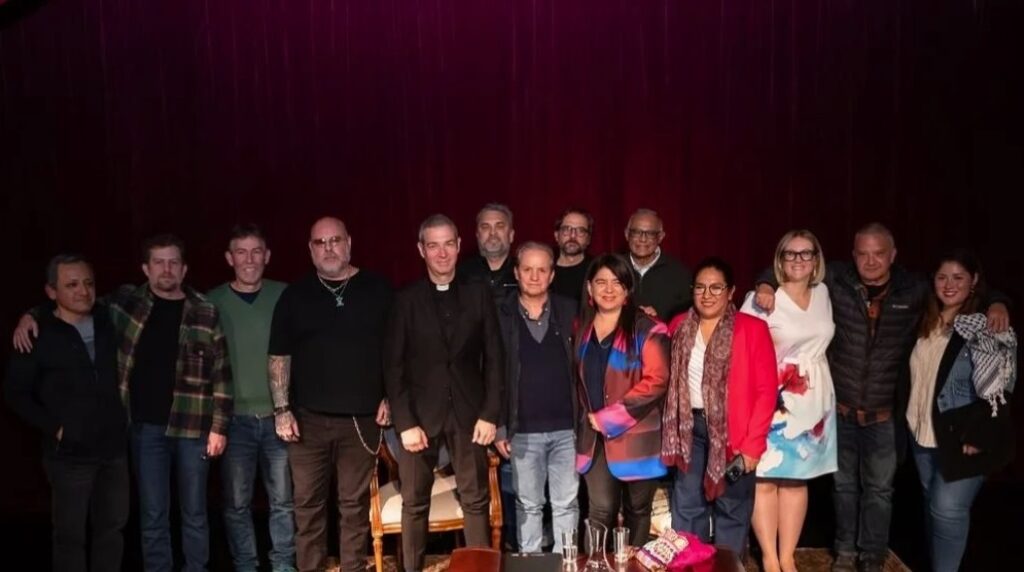
While Pope Leo XIV figures out the next moves of his Papacy, it is necessary to delve deeply into the reception of the zero-tolerance concept in Catholic discourse as it is clear that, there is a gap between the stated goals, what actually keeps happening, and the fact that many survivors are still far from even being acknowledged as victims of abuse.
Now a staple of Catholic discourse, the concept emerged after the devastating revelations of the late 20th century in the United States. Despite its current prominence, there is little evidence of an actual, effective, appropriation of what the concept entails beyond the United States, Canada, Australia, and France.
The Catholic appropriation of zero-tolerance happened in the early 2000s, as a consequence of the dialogues happening in Dallas between the bishops and diverse groups of the Church in the United States. That meeting ultimately shaped the current Charter for the Protection of Children and Young People.
Dallas resembled, in various ways, the meetings that the German Catholic Church has every decade or so, the so-called Der Synodale Weg or The Synodal Way. It followed a proactive understanding of intra-church dialogue and, in that respect, is a forerunner Pope Francis’s Synod on Synodality, a call to build a “synodal” Church that, no surprise, brings out the worst angles of the most reactionary factions of the Catholic Church.
Lone Ranger
Despite the now established idea of zero-tolerance, the then lone-ranger effort of the United States Conference of Catholic Bishops’ leader and now emeritus archbishop of Washington, D.C., Cardinal Wilton Daniel Gregory was hard to predict.
He was only able to push for a different understanding of the crisis and the required measures, after the bankruptcy brought by decades of denialism, gaslighting, and harassment of survivors from up until then powerful clergy as Cardinal Bernard Law.
Law presided a gargantuan scandal in Boston, until then, one of the richest sees in the U.S. and an epicenter of the global crisis as Spotlight, the movie released in 2015 describes.
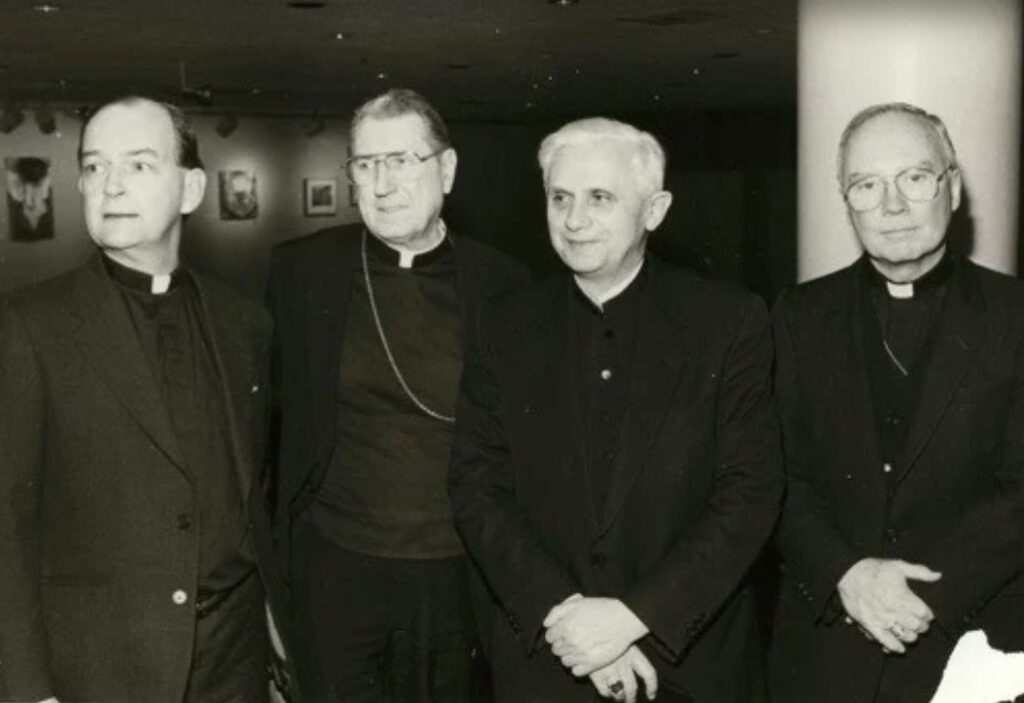
Many Catholics, clergy and laypersons, were still intent on discrediting accusations of sexual abuse and to defend predators. The previous installment of this series went into the details of how John Neuhaus’s First Things magazine, a powerhouse of Conservative thinking in the English-speaking world, lend support to Marcial Maciel in 2002 along those lines.
In November 2001, Gregory became the USCCB’s unexpected leader, first African American ever elected while serving as the bishop of Belleville, a relatively small diocese in Illinois with a flock of about 100,000, where Catholics comprised less than 13 percent of the total population across its 28 counties.
Despite the headwinds, Gregory pushed for change, forced by the very active U.S. law enforcement, media pressure, and his own realization of the scale of the crisis. In doing so, a set of criteria for a zero-tolerance policy has been emerging over the many iterations of the Charter.
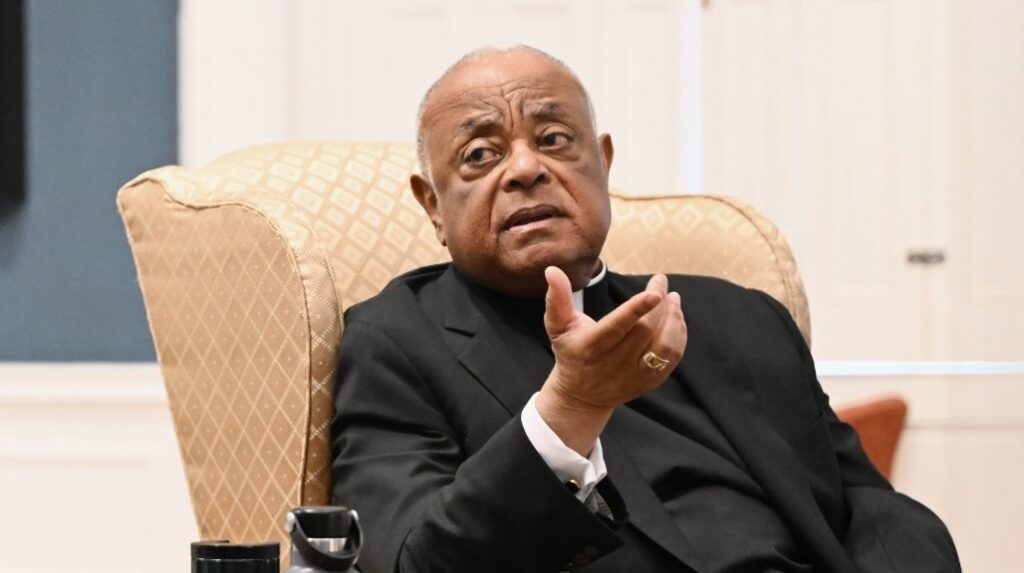
Some of that experience is evident when using the search engine at Tutela Minorum’s website, the global body in the Catholic Church addressing the issue. A search for “zero tolerance” returns twelve matches, from May 2024 to February 2025.
The most relevant are portions of a relatively recent document titled Universal Guidelines Framework, available here as a PDF. The rest of the matches are pieces of statements from members of Tutela Minorum.
Guideline 1, titled “Committed Church leadership and culture”, says: “1.1. The church authority publicly commits to safeguarding, with a zero-tolerance stance towards abuse.” Said criterion is somehow developed over three indicators none of which mentions zero-tolerance. The lack of a specific benchmark as to what zero-tolerance entails leaves the issue open for interpretation.
Guideline 5, titled “Culturally responsive” addresses zero-tolerance in the first indicator of the first criterion: “5.1. Safeguarding protocols are adapted to the church body’s unique cultural and social contexts. 5.1.1. Safeguarding policies and procedures (especially the Code of Conduct and complaints procedures) are contextualized to the culture of the local church, while aligning with universal principles (such as the UN Convention on the Rights of the Child), ensuring that the zero tolerance approach to abuse is maintained within the local cultural context.”
Guideline 7, titled “People management” talks, like 5 does, of zero-tolerance in the first indicator of the first criterion. It states: “7.1. A strong commitment to safeguarding underpins the church’s recruitment. 7.1.1. The commitment to safeguarding and zero tolerance approach to abuse are explicit in advertising, screening, and recruitment for personnel.”
Show me the benchmarks!
There is no actual document on the website stating the consequences for dismissing the rather vague notion of zero-tolerance “stance” or “approach” endorsed by Tutela. Whoever expects consequences for not hitting the benchmarks for, as a possible example, removal from ministry, should be ready for disappointment.
Same could be said about cooperation with civil authorities. The issue is not irrelevant as ultimately there is a gradient of possible choices in that respect: from actively reporting to authorities as soon as a religious leader becomes aware of abuse, all the way to only cooperating when forced by an authority.
Following what happens in Spain one would find even another step in that gradient, a case where acknowledgment of the authority’s ruling is off the table. On Monday, June 23, the Opus Dei in Spain’s Basque Country challenged the local judges’ authority. They claim that a lay male professor at a Catholic college, already sentenced as guilty by a judge is, as far as they are concerned, “innocent.”
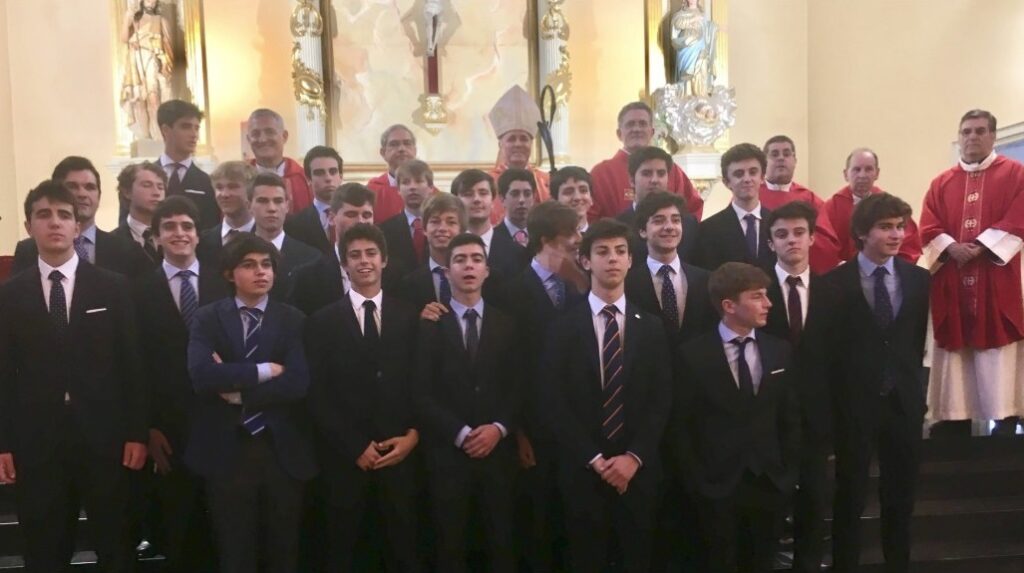
The case involves Juan Cuatrecasas, a former Spaniard MP who proved abuse against his son, was willing to litigate and win the case and yet, for Opus Dei, sentences from a civil authority matter little or nothing.
The attitude from the Opus Dei in the Basque Country echoes the attitude of a major figure of that catholic religious organization, Peruvian Cardinal Juan Luis Cipriani. As the Opus Dei says about the sentencing in Spain, Cipriani disdained a ruling from Pope Francis’s on the case providing the worst-case scenario of such dismissive attitude towards the Catholic Church’s own leadership.
Zero-tolerance as slogan
Both cases involving Opus Dei, that of Cardinal Cipriani, and the reluctance to acknowledge abuse at Gaztelueta, Spain, offer pristine examples of how zero-tolerance remains a slogan.
Back in January, the world came to know that the emeritus archbishop of Lima, Peru, Cardinal Cipriani, had been under some “punishment” for his active role in the abuse of a young male under his care, although there was never a formal announcement of the “penalty” and the reasons why he was “punished.”
We know Rome accepted almost immediately his resignation as archbishop of Lima after he reached 75 in 2019, when he officially retired. As head of the oldest diocese in South America, Cipriani played a key role in the cover-up of abuses in the Sodalitium of Christian Life, besides the case of abuse acknowledged as such by Rome.
Cipriani’s case echoes similar “punishments” issued against Mexican Marcial Maciel and Chilean Fernando Karadima. First, because the actual reach and reason of the “penalty” remained secret, a sort of private agreement between the Pope and the guilty party. It entailed “a life of prayer,” and restrictions on the use of clerical attire in public and, overall, in any public performance as priest.
Despite the reprimand of sorts, Cipriani saw fit to disdain Pope Francis’s authority. In January, he went back to Peru to attend ceremonies celebrating him, in clerical attire, at the mayoralty of Lima.
As a consequence, the Vatican sent a file with Cipriani’s information to Spaniard newspaper El País. Cipriani went into Maciel mode, called himself a victim of a campaign, and said he had only accepted the pontiff’s “penalty” out of discipline and obedience, not because he was guilty.
Despite the knowledge about the “punishment” on Cipriani since late January, during Pope Francis’s funerals in late April, he brazenly paraded through the streets of Rome in clerical attire, at times even in full choir garments inside Saint Peter’s Basilica. In doing so, he was challenging, down to his very tomb, the Pope who found him guilty of abusing a minor under his care.
Cipriani’s case showcases the deep disconnect between the frequent references to zero-tolerance as a policy in the Catholic Church, and what one sees in full display in the attitudes of top officers of an institution undergoing a global crisis of trust.
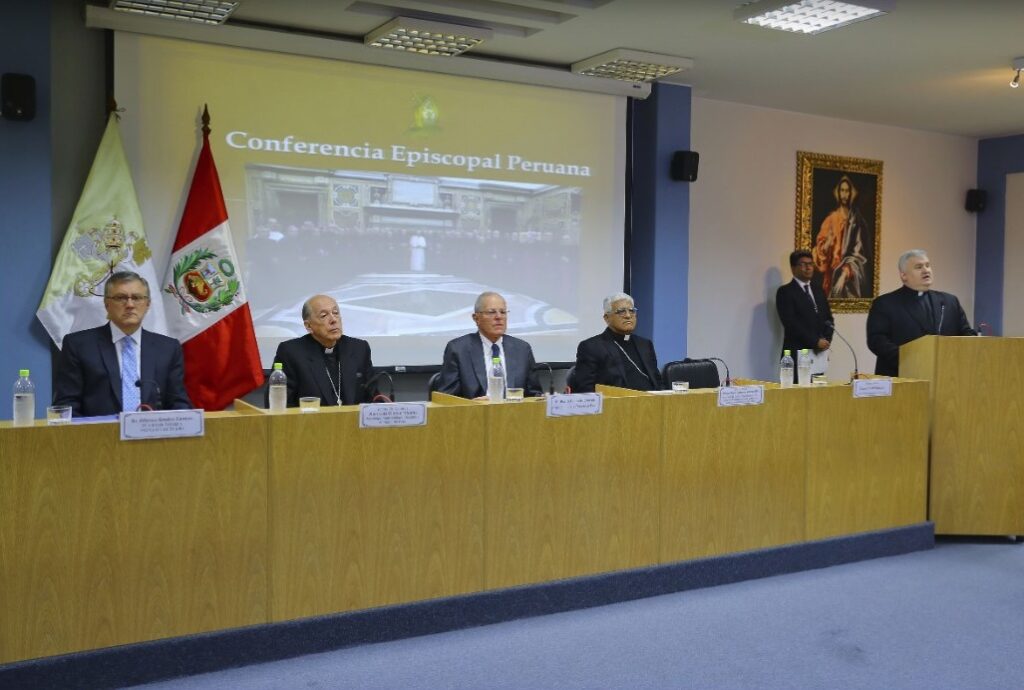
In that respect, it is clear that something is amiss when an institution talks the talk about zero-tolerance, but it is actually unable to walk the walk of enforcement of already timid punishments of both predatory and disloyal clerics such as Cipriani, as the story linked after this paragraph explains.
Another potential standard would be that of reassignments. In what cases would it be acceptable for temporarily suspended clergy to perform some duties and who would enforce compliance? What would be the consequences for noncompliance?
It is easy to understand that given the different contexts in which the Catholic Church works, it is hard to expect a single definition for the criteria, but the absence of consequences for noncompliance is what brought the current disaster.
One would argue that a first area where a robust zero-tolerance policy would be necessary and useful to validate the use of such a catchphrase would be compliance with the Church’s own bylaws, rules, and regulations: the Code of Canon Law and other regulations within that institution.
A clear example of it is the response to Pope Francis’s request to set a commission charged with preventing sexual abuse in each diocese. The bishops’ conferences in Brazil and Mexico have not reached that goal since he issued the 2019 reform.
At least up until mid-2024, Brazil had been either unable to comply or unwilling to report its compliance, as the story linked above told then. As for Mexico, around the same time, less than half the Catholic dioceses in the country had complied with Pope Francis’s request, as the story linked below describes.
Given that Catholic bishops enjoy a high degree of latitude in their dioceses, using zero-tolerance as catchphrase comes cheap, with no consequences for failure.
Zero-tolerance, a history of sorts
The United States Conference of Catholic Bishops officially adopted a notion of zero-tolerance with the aforementioned Charter, commonly known as the Dallas Charter. The USCCB unanimously passed it in June 2002, after a momentous reckoning of the conference that had been trying to minimize the scale of the issue.
Alongside the Dallas Charter, the US bishops had the merit of commissioning what was, more than 20 years ago, the best ever report on the issue, the so-called John Jay Report or, more precisely, The Nature and Scope of the Problem of Sexual Abuse of Minors by Catholic Priests and Deacons in the United States, originally published in 2004 and available here, as a PDF file, at the U.S. Library of Congress.
Good enough then, but not enough to stand the test of time, as some of the evidence behind the study was heavily biased towards cases involving male minors. An unintended bias, a byproduct of the difficulties to gather information about abuse of females, it has been the source of the unsupported assumption that abuse is connected with male same-sex attraction or preference.
This idea is nowadays under fire as there is more evidence about the abuse of females, underaged or otherwise, both by male clerics, as the story linked before of the abuse of a Mexican nun shows, and abuse coming from other nuns, as the story linked after this paragraph proves.
Despite all the issues, the Charter and the Report are evidence that the Catholic Church in the U.S. was willing to move forward and find solutions. For the report, they paid market-rates to the John Jay College of Criminal Justice, a prestigious public college, with a stellar program on criminology, and not to a Catholic university such as Georgetown.
Only after the scandals
Even if by the end of the 20th century some US bishops were willing to go as far as to ask Rome to defrock priests from ministry for sexual abuse of minors, there were divisions at the bench, as zero-tolerance entailed a commitment to mirror the enforcement of zero-tolerance policies in criminal justice in that country.
One cannot dismiss that commissioning the report and developing a zero-tolerance approach happened after the scandals in dioceses in the states of Louisiana and Massachusetts going back to the 1980s, where priests remained in ministry despite repeated instances of abuse.
That was the case in the archdiocese of Boston of John Geoghan (see the story above). The authorities charged him with a minimum of 130 counts of abuse of minors over more than 30 years of “service.” As Maciel, he had an uncle who was priest in the archdiocese, with friends in the “right places” who repeatedly offered new “second chances” after stints in rehabilitation facilities.
In that respect, commissioning the report and betting on a zero-tolerance approach, were reactive measures to decades of cover-ups, disguised reassignments, denialism and, more so, the harassment and gaslighting of survivors and their families. Even if it now appears as a proactive change in institutional behavior, it was not in its origins.
The USCCB was, as almost any other national conference of bishops then, marred by deep-seated disinterest to address the issue, complicit attitudes, entailed in what Robert Sipe calls the “scarlet bond,” and a certain predisposition of the Catholic hierarchy to play victim.
Said narrative of victimhood had some historical support. From the laws barring Catholics from public office in England and Prussia in the aftermath of the Reformation, to the brutality of the French Revolution (1788-99), the Cristero War in Mexico (1926-9) or the Civil War in Spain (1936-9) to the cases of Eastern European Cardinals, such as József Mindszenty, hiding in U.S. embassies behind the iron curtain in the 1950s.
These were elements craftily used by predators such as Marcial Maciel, to render themselves as victims of wide conspiracies, aimed at destroying them and their Church at large. This allowed abuse to persist.
Endgame
Despite it all, USCCB acknowledged the endgame scenario they were facing by the early 21st century, a byproduct of the creativity and vitality of the Common Law, the U.S. law enforcement proactive approach to deal with these issues, and the way U.S. media, prominently the National Catholic Reporter, was willing to dive into the issue with a passion similar to The Washington Post’s treatment of Watergate.
USCCB did what it did, not so much of its own volition, but after an avalanche of reports, journalistic, academic, personal, and otherwise, showed patterns of dismissing early signs of abusive behavior. Sometimes, dismissal was the byproduct of labor shortages within the Catholic Church, as the Church itself limits who is authorized to perform certain rites but, often, other issues played a role.
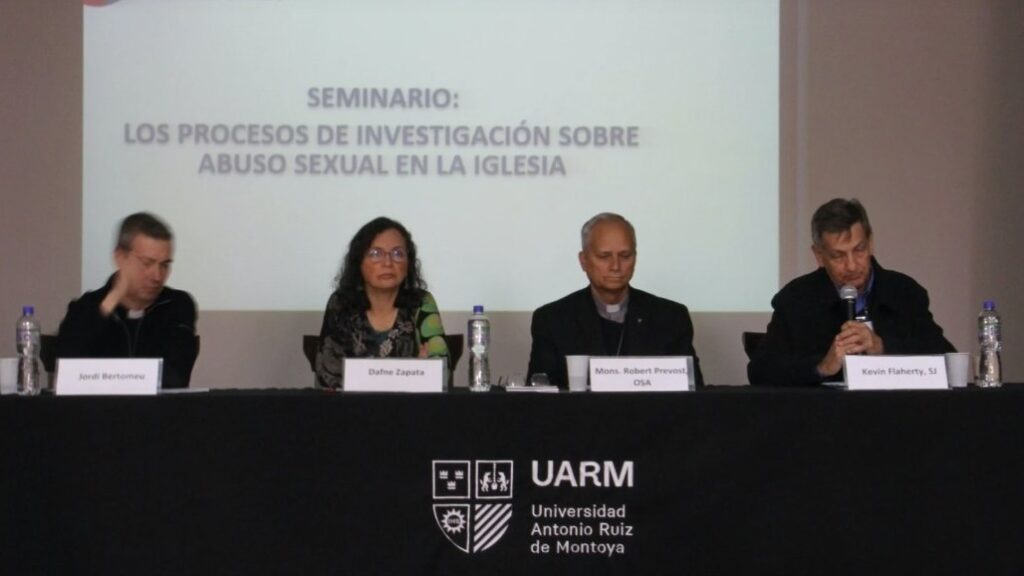
Even John Paul II had to admit it, as his statement to U.S. cardinals from April, 2002, available here, proves. It was, in his own words, a “difficult and complex situation,” going as far as to acknowledge that he was “deeply grieved.”
He spelled those words despite his statement, little over 14 months before, on January 4, 2001, when he praised and publicly thanked Maciel “for the words he addressed to me on everyone’s (in the Legion of Christ) behalf.”
The path and the root
The USCCB’s path even if formally accepted by Rome back in 2002, remains, up until today, an anomaly, with France being the sole similar case in Europe.
Where the French Bishops followed the USCCB’s lead, by commissioning a landmark study from policy studies guru Jean-Marc Sauvé that actually enhanced the John Jay Report’s reach, on the other side of the Pyrenees, in Madrid, their Spaniard brethren, hired Javier Cremades, numerary of the Opus Dei, to come up with a study of sorts, offering little or no insights on the nature and reach of the crisis in Spain.
Where in Paris the bishops engaged an expert, walking the walk of rigorous self-examination exposing systemic issues, in Madrid the prelates went for a friendly voice, in the expectation of a tool to control the narrative.
And even worse. Where the French bishops acknowledged in 2021 a minimum of 216 thousand victims, their Spaniard brothers downplayed the issue to the minimum: 1,803, by Cremades’s report, but only 806 by the bishops’ count. Hard to believe if one knows that, even if smaller, Spain’s population has been two-thirds of France’s for the last century or so, a disparity underscoring the unreliability of Spain’s reported figures.
The concept of zero-tolerance has its roots in criminal law policy studies going back to the 1960s. More specifically in the policies crafted by the U.S. Federal government to enforce tight restrictions on the consumption of alcohol by underaged individuals while driving motor vehicles.
It is impossible to go over the history of zero-tolerance in those areas but, as far as alcohol consumption, zero-tolerance reached a milestone when Ronald Reagan signed into law the so-called National Minimum Drinking Age Act of 1984, a federal mandate forcing US states to enact local legislation to prevent underaged drinking and driving. The policy was successful, among other reasons, because of the involvement of grassroots organizations such as Mothers Against Drunk Driving.
Another source of its use comes from the so-called War on Drugs. Originally launched by Richard Nixon around the same time, the 1970s. The record of zero-tolerance policies in that area is less successful, as it entails brutal sentencing practices. It was associated with the George L. Kelling’s and James Q. Wilson’s piece from The Atlantic magazine “Broken Windows” published in 1982, leading to law enforcement frameworks such as the “Three-strikes laws”. However, due to its usefulness in preventing drunk-driving, by the late 1980s the notion of zero-tolerance had some credibility in the English-speaking world.
It was in that context that the notion crawled into the USCCB’s response to the sexual abuse crisis. Four years after his election as Pope, Francis embraced a rather diluted version of the USCCB’s understanding of zero-tolerance.
On September 21, 2017, during a speech to Tutela Minorum, the Pontifical Commission for the Protection of Minors, founded by him back in 2014, he said:
…the Church irrevocably and at all levels intends to apply the zero-tolerance principle against the sexual abuse of minors.
Little over three months later, while traveling in Chile, Francis had a “Damascus moment,” when he confronted the pervasive effects of the crisis. His approach at least until the very last day in Chile, was the standard operating procedure of his Church based on secrecy and denialism.
The abominable lone predator
The day of his departure for Peru, the second leg of his pastoral journey in 2018, Francis asked once again for proof of accusations against Juan de la Cruz Barros, a member of the so-called “Karadima bishops,” an informal subset of the Pious Priestly Union, an organization of Chilean priests, spearheaded by noted predator Fernando Karadima.
Karadima was already the subject of a probe that yielded little or no actual consequences to him. As it still happens today, the “punishment” was to restrict his ability to perform publicly as priest. Karadima was unwilling to abide, and his superiors at the archdiocese of Santiago de Chile were unwilling to enforce.
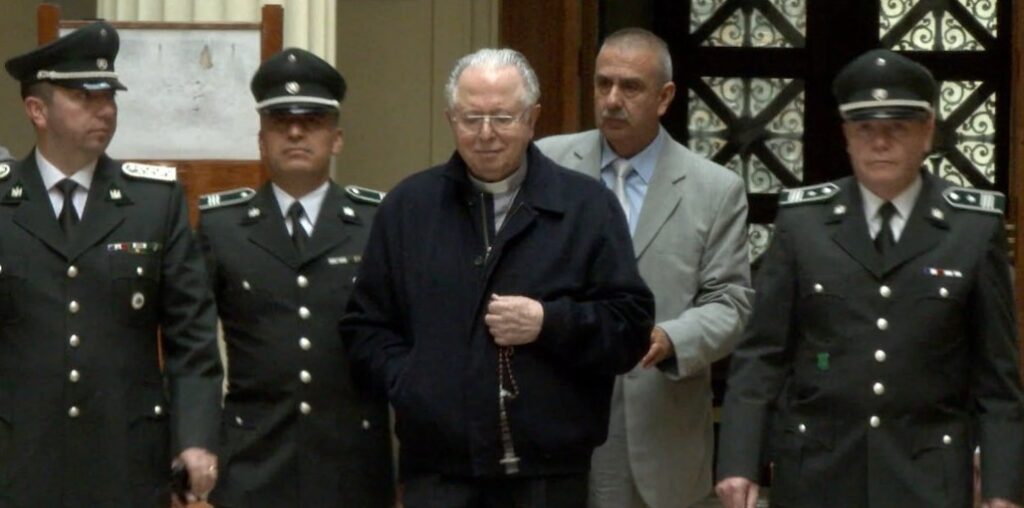
For a while, early in February 2011, news and pictures about Karadima’s presiding over Masses shocked public opinion in Chile. He was performing rituals and sacraments for faithful willing to bet on his innocence. As this Spanish-language story from Chilean medium El Mostrador tells Karadima had a loyal flock.
They were willing to follow him to the gates of Hell, despite the slap of the wrist by both Benedict XVI and then archbishop Ricardo Ezzati (opens a PDF in Spanish).
Three years after the scandal, another Chilean medium, CIPER (opens content in Spanish), was telling stories about funerals performed by Karadima at the convent’s chapel as any parish priest would.
The canonical excuse was that he was performing as priest at the chapel of a convent not regularly open to the public. However, as those pieces from two different Chilean media prove, there were no actual restrictions to access the chapel or for Karadima to perform as priest.
Suffice to say, that not anyone, not even a priest in good standing would be able to simply appear at a convent’s chapel and perform as such without some vetting from the superior and the bishop where the chapel is located.
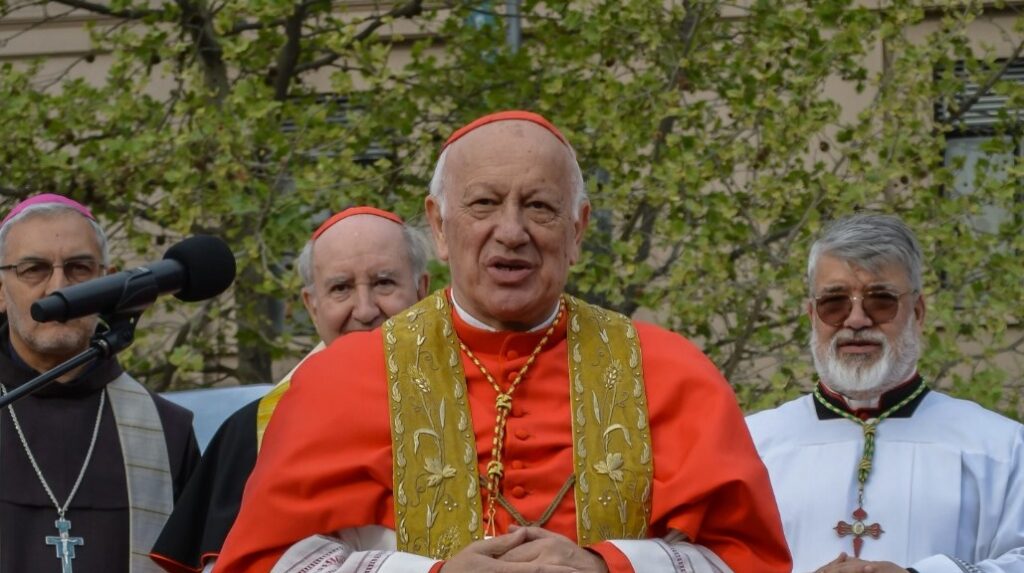
Chilean gothic
In response, Cardinal Ezzati Andrello said he was unable to enforce the restrictions on Karadima as “he was not a policeman,” as reported by this Spanish-language story while sticking to the self-serving excuse of the “lone predator.”
The “explanation” had been already used with Marcial Maciel in Mexico and was adapted to Chile since 2010, when then Secretary of State of Benedict XVI, Cardinal Tarcisio Bertone went there, allegedly for reasons other than Karadima’s case, although he offered that “explanation” for that case there.
That year, Bertone linked abuse to the “lone predator” myth, to same-sex attraction, and not to the Church lacking standards to deal with abuse, as this story, in Spanish, from 2010 reports.
The “lone predator” narrative, present in what the Church says about Maciel and Karadima, is useful to gaslight and divert. It allows the kind of claims made at the time by Barros about not knowing what Karadima was doing. He was saying that despite the many testimonies from Chilean survivors identifying Barros as an accomplice to Karadima.
That was less credible as Chilean media had been reporting about the growing influence of the five “Karadima bishops,” Barros and four others, who advanced their careers because of Karadima’s help and later, when things went awry, they became key players in Karadima’s multipronged defense.
Francis went as far as to offer an impromptu interview to an Argentine journalist while preparing for his Mass in Iquique, from where he would fly to Lima, Peru. In the interview he repeatedly asked for “evidence,” “proof,” of Barros’s wrongdoing.
Francis appointed Barros as bishop of Osorno back on January 10, 2015. Unlike most appointments to dioceses in Latin America, going off the radar of public opinion, Barros’s sparked unprecedented mass mobilizations all over the diocese, and elsewhere in Chile.
It would be a few days later, during the in-flight press conference on January 22, 2018, going back to Rome, that he adopted the “zero-tolerance” idiom when talking about the Peruvian Sodalitium while comparing himself to Pope Benedict XVI take when dealing with…
- …one (case) involving the Legionaries (of Christ); it was already resolved at the time by Pope Benedict XVI who was very firm and determined in that situation. Benedict did not tolerate these things. I learned from him not to tolerate them either.
Damascus by way of Chile?
After that question on the Sodalitium and indirectly the Legion of Christ, Francis would answer another question about the same issue:
- I made only one statement about Barros, not several. I spoke in Chile, in Iquique, at the end. In Chile, I spoke twice about sexual abuse: forcefully before the government, which meant before the entire country, and in the cathedral, with the priests. What I said to the priests is what I feel most deeply about the matter. You know that Pope Benedict began with zero-tolerance, I continued with zero-tolerance, and, after almost five years as Pope, I have not signed a request for pardon.
Although he admitted the “infelicitous” nature of his statement to the Argentine TV, he insisted that there was no actual testimony against Barros who, ultimately, would be removed from office on June 11, 2018.
Sadly, the Chilean Catholic Church seems to be unable to learn a lesson from Pope Francis’s falling on the way to Damascus as new issues emerge and old cases remain in a sort of limbo.
Early in June, Carol Crisosto Cádiz, one of the Chilean laypersons protesting ten years ago Barros’s appointment, reported about how the Chilean bishops are ready to give a second chance to a priest convicted of sexual abuse by both the civilian authorities and Catholic leadership in that country.
Her story, available here in Spanish, calls Sergio Pérez de Arce, the archbishop of Concepción, to think twice about the future of Hernán Henríquez Rosas.
Despite the fact that Chilean civilian and church tribunals found Henríquez guilty, there is a chance of him going back to ministry as early as 2028, with a potential for full reinstatement by 2033.
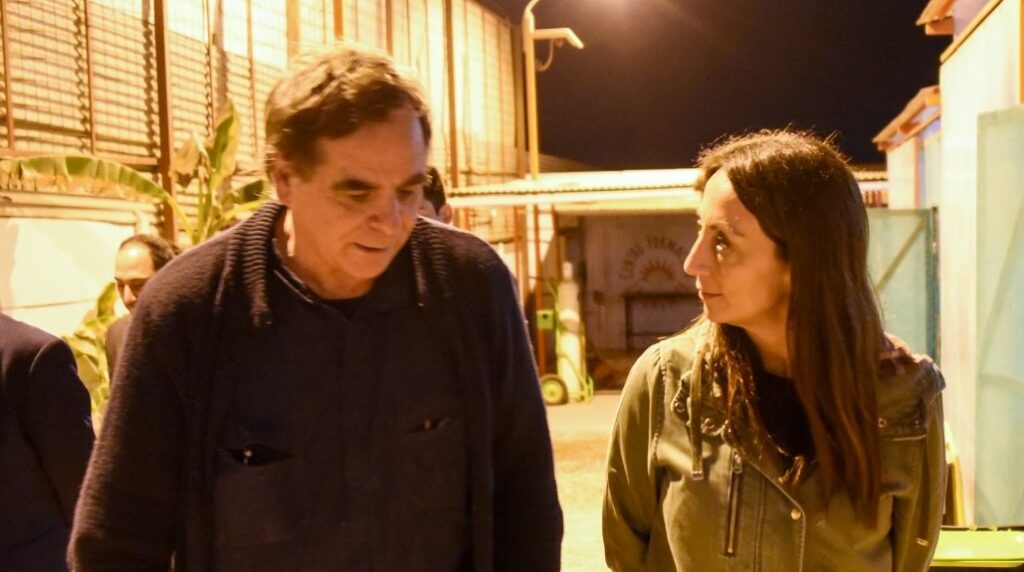
More recently, on Tuesday June 24, former Chilean priest Felipe Berríos del Solar, got “good news” from the authorities after they dismissed a case where a female accused him of one instance of sexual attack of a minor (15-year-old at the time) going back to 2000.
The authorities are not exonerating him. They acknowledge the validity of the claim, but they cannot go further given the usual restrictions stemming from the statute of limitations. That is why, as far as the Jesuits is concerned, the case had merits, hence the decision of the order to expel Berríos, back in May 2024.
Overall, seven females, ranging from 14 through 23 at the time of the different incidents, happening between 1993 and 2009, accuse Berríos of sexual abuse.
Their decision shocked, once again, the already frail structures of the local Catholic Church as he was a champion of social justice, a Chilean Abbé Pierre, dealing with similar issues as the French predator: homelessness, poverty, and associated maladies and, sadly, confronting these days similar charges to those crushing the legacy of Abbé Pierre in France.
What is worse, Berríos, as many other Chilean priests did his best to portray himself as the true heir to Saint Alberto Hurtado (1901-52), a Chilean Jesuit who was also a champion of the poor and marginalized and suffered, at his time, harassment from the then bishops of Chile who forced him out of several ventures where he was trying to perform, with relative success, his duties as priest.
In any case, Francis’s quoting Benedict XVI as the inspiration for his own approach while leaving Chile, makes it necessary to go deeper into Ratzinger-Benedict XVI’s role in the use of zero-tolerance approaches, which will be the focus of the next installment of this series.


